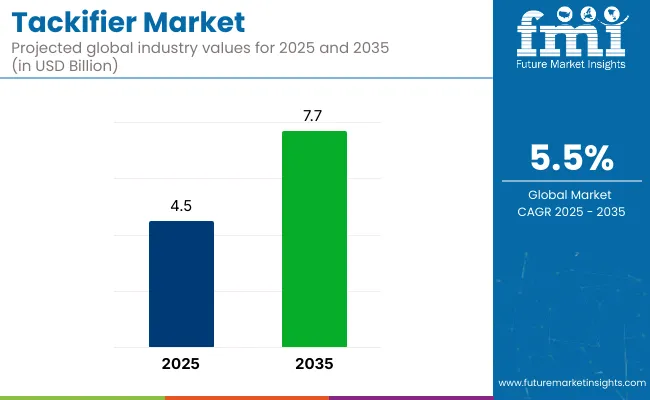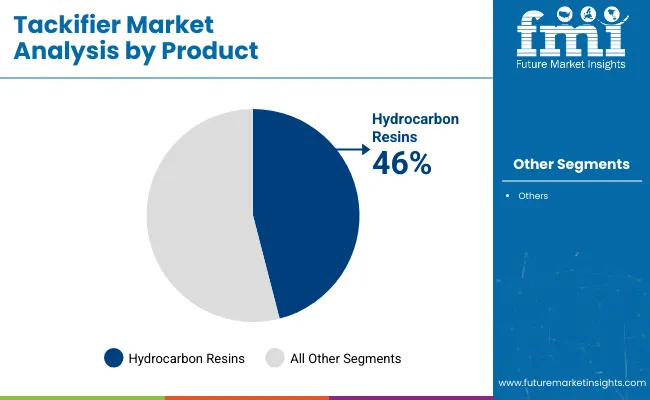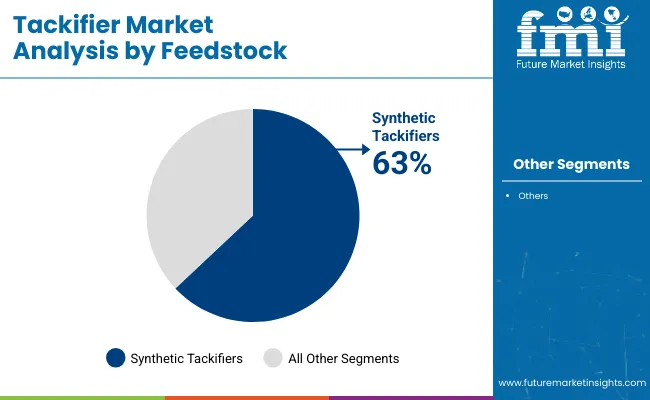The global tackifier market is projected to grow from USD 4.5 billion in 2025 to more than USD 7.7 billion by 2035, reflecting a compound annual growth rate (CAGR) of 5.5%.

This expansion is being supported by rising demand across pressure-sensitive adhesives, hot-melt adhesives, and rubber-based products, particularly in packaging, automotive, and construction applications.
Tackifiers are used to enhance adhesion properties such as tack, peel, and shear strength. These materials play a central role in adhesive and sealant formulations for applications that include labels, tapes, hygiene products, footwear, and insulation systems. Increasing demand for flexible and high-performance adhesive technologies in emerging economies continues to strengthen global consumption. Growth in infrastructure, rapid industrial activity, and expanding e-commerce logistics across Asia-Pacific are driving regional adoption. China, India, and Southeast Asia have become key contributors to tackifier market volume due to strong demand in packaging and automotive production.
Volatility in raw material prices, especially for petroleum-derived hydrocarbon tackifiers, presents ongoing challenges related to cost stability and procurement planning. In response, producers are investing in alternatives such as rosin-based and terpene-based resins. Bio-based tackifiers developed from renewable feedstocks like pine chemicals are gaining traction in markets with heightened environmental scrutiny. These products offer enhanced biodegradability and reduced environmental impact while meeting the performance criteria of conventional systems.
In rubber applications, tackifiers improve green tack and interlayer adhesion, which is critical in tire manufacturing and industrial rubber production. Within the construction sector, tackifiers are used in adhesives applied to thermal insulation panels, flooring systems, and laminated building materials where strong initial tack is essential.
Research and development is focused on new tackifier formulations compatible with various base polymers including polyolefins, polyurethanes, and ethylene-vinyl acetate. These innovations support growing demand from sectors such as medical devices, electronics, and hygiene where adhesives must exhibit low odor, minimal volatile organic compound (VOC) emissions, and consistent performance.
Hydrocarbon resins are projected to account for approximately 46% of the global tackifier market share in 2025 and are expected to grow at a CAGR of 5.4% through 2035. These resins, derived from C5, C9, or DCPD feedstocks, are widely used in packaging, labels, tapes, and hygiene products due to their compatibility with synthetic rubber and hot-melt adhesives. Their thermal stability and low color index make them suitable for industrial-scale formulations. As consumer product packaging and hygiene demand increase globally, hydrocarbon resin tackifiers remain a core material in adhesive production, especially across Asia-Pacific and North America.

The synthetic tackifiers segment is estimated to hold approximately 63% of the global market share in 2025 and is projected to grow at a CAGR of 5.6% through 2035. These tackifiers offer greater control over molecular structure, performance characteristics, and compatibility with a variety of elastomers. They are primarily used in high-volume adhesive applications where consistency and performance in varying environmental conditions are essential. As industrial adhesive production continues to expand in sectors like automotive, electronics, and construction, synthetic feedstocks are expected to remain the preferred choice for manufacturers requiring high-purity and high-thermal resistance tackifier inputs.

The United States is one of the largest tackifier markets globally, driven by its massive adhesives industry. North America as a whole generated about USD 1.3 billion in tackifier revenue in 2023, with the USA accounting for the majority share. Tackifier demand in the USA is growing at a healthy pace, fueled by the extensive use of adhesives in packaging, construction, and automotive manufacturing.
Robust e-commerce packaging needs and the shift toward lightweight automotive assembly (using structural adhesives in place of welds) are key contributors to USA tackifier consumption. However, the USA market also faces cost challenges from volatile hydrocarbon feedstock prices and stringent VOC regulations, prompting innovation in tackifier formulations.
Canada’s tackifier market is smaller than the USA but exhibits steady growth alongside the North American trend. The demand is largely tied to Canada’s packaging industry (for food and consumer goods) and the construction sector, which utilizes adhesives for sealing and bonding. Canadian adhesive manufacturers increasingly require high-performance tackifiers for packaging tapes, labels, and building materials, mirroring USA industry dynamics.
Growth is moderate and supported by imports as well as regional production, with Canadian demand benefiting from the overall North American push for more sustainable, low-VOC adhesives. As a result, Canada is expected to maintain a stable growth trajectory in tackifier consumption.
The UK is a significant tackifier market in Europe, supported by its large consumer goods and e-commerce packaging sectors. As part of the European region, the UK contributes to the continent's overall share in global tackifier revenues. Key drivers include demand for pressure-sensitive adhesives in labels and tapes for packaging, as well as specialty adhesives used in the UK’s automotive and construction industries.
The growth rate in the UK is moderate, with a focus on sustainable adhesives. The UK’s commitment to sustainability and strict EU/UK regulations on chemicals are pushing adhesive formulators to adopt bio-based tackifiers and low-VOC products, gradually influencing market composition.
France represents another important European tackifier market, with strong ties to the adhesives and pine chemicals industry. France hosts notable tackifier producers and suppliers, indicating a solid domestic supply chain. The French market’s demand is driven by packaging adhesives (for cosmetics, luxury goods, and food packaging) and industrial applications like bookbinding and footwear, where tackifiers are used for bonding.
Growth is steady in line with Europe’s overall trajectory. Additionally, France’s adherence to EU sustainability initiatives means a growing share of tackifiers used are rosin-based or bio-based to reduce environmental impact, and local companies have been innovating in light-colored, more stable tackifier resins for high-end applications.
Germany is the largest tackifier market in Europe, owing to its expansive manufacturing base. German demand is bolstered by the automotive industry (Germany is Europe’s automotive hub) using advanced adhesives, as well as a high volume of packaging and construction activities. Germany constitutes a substantial portion of Europe's tackifier consumption, outpacing other EU countries.
Analysts note that Germany is expected to witness the highest growth in Europe’s tackifiers market, supported by its strong industrial output. Tackifiers in Germany are critical for automotive assembly adhesives, appliance manufacturing, and durable packaging.
The market is growing moderately, with a shift toward high-performance synthetic tackifiers and increasing interest in eco-friendly resins to comply with EU regulations. Major chemical companies in Germany are actively supplying or developing tackifier materials, helping maintain Germany’s leadership in this segment.
South Korea’s tackifier market is robust relative to its size, anchored by the country’s strong electronics, automotive, and packaging industries. As part of the Asia-Pacific region, which holds the largest share of global tackifier demand, South Korea contributes significantly, with local producers serving both domestic and export markets.
Tackifier demand in South Korea is driven by pressure-sensitive adhesives for electronics (e.g., adhesives used in displays and semiconductor packaging) and the automotive sector (for interior tapes, labels, and assembly adhesives). Growth is steady, roughly in line with global averages, as the country’s packaging and consumer goods sectors continue to expand.
South Korea also benefits from having integrated supply chains, ensuring local availability of high-quality tackifiers. The market is gradually incorporating bio-based tackifiers in response to global sustainability trends, though synthetic petroleum-based resins remain prevalent due to their performance.
Japan’s tackifier market is mature and characterized by high-quality, specialized products. With a well-established adhesives industry, Japan’s demand for tackifiers comes from its automotive manufacturing, electronics assembly, and bookbinding sectors, among others.
Japanese tackifier consumption is stable and growing modestly, supported by domestic producers who supply rosin esters, terpene phenolic resins, and synthetic tackifiers. These companies give Japan a degree of self-sufficiency in tackifier supply and drive innovation, particularly in terpene-based tackifiers used in high-performance pressure-sensitive adhesives.
Market growth is moderate, reflecting a balance of new opportunities (e.g., adhesives for emerging electronics and electric vehicles) and a relatively saturated traditional market. Japanese manufacturers are also early adopters of technological advancements in tackifiers - emphasizing products with excellent thermal stability and clarity to meet the stringent requirements of electronics and automotive applications.
Sustainability is a growing focus in Japan, aligning with global moves toward low-VOC, environmentally friendly adhesives.
China is the world’s largest tackifier market by volume and value, underpinned by its massive manufacturing and packaging industries. In 2024, China’s tackifier market was valued at over USD 1.6 billion, representing a substantial portion of global demand. It is expected to grow steadily, supported by China’s strong base in packaging (thanks to a booming e-commerce sector) and automotive production.
China’s construction boom and expanding electronics manufacturing also contribute heavily to adhesive and tackifier consumption. Notably, China is not only a top consumer but also a leading producer of raw materials for tackifiers - it is a major source of gum rosin (from pine trees) and petroleum-based resins.
This vertical integration offers Chinese tackifier producers cost advantages and supply security. The market trend in China is toward higher-quality tackifiers to meet advanced application needs, and there is rising interest in bio-based tackifiers domestically as sustainability becomes important. Still, synthetic tackifiers dominate due to cost-effectiveness and performance, aligning with China’s focus on durable, high-volume manufacturing.
India’s tackifier market is fast-growing, propelled by rapid industrialization, urbanization, and infrastructure development. While smaller in absolute size compared to China or the USA, India’s demand for adhesives (and thus tackifiers) is climbing quickly in sectors like packaging (especially flexible packaging for food and consumer goods), construction, and textiles.
Recognizing this growth, companies are investing in India to increase local production capacity. Such investments point to robust local demand and a positive outlook. India’s market expansion is tied to the rise of e-commerce (driving packaging needs), government infrastructure projects (requiring construction adhesives), and a growing automotive assembly sector.
Tackifiers in India are used in hot-melt adhesives for packaging and tapes, as well as in rubber adhesives for footwear and tire applications. Market growth through 2025 is expected to outpace many developed countries, making India an attractive market for global tackifier suppliers.
The country is also gradually adopting eco-friendly tackifiers as global brands with operations in India seek adhesives that meet international sustainability standards. However, cost remains a deciding factor in this price-sensitive market.
Market participants are prioritizing investments in resin purity, thermal resistance, and shelf-life optimization to meet evolving industry standards. Localization of supply chains and the development of specialized product lines are expected to support long-term competitiveness across the tackifier industry.
The market is valued at USD 4.5 billion in 2025.
The market is forecasted to reach over USD 7.7 billion by 2035, reflecting a CAGR of 5.5%.
Hydrocarbon resins will lead the product type segment, accounting for 46% of the global market share in 2025.
Synthetic tackifiers will dominate the feedstock segment with a 63% share in 2025.
Hydrocarbon resin tackifiers are projected to grow at a CAGR of 5.4% from 2025 to 2035.






Our Research Products

The "Full Research Suite" delivers actionable market intel, deep dives on markets or technologies, so clients act faster, cut risk, and unlock growth.

The Leaderboard benchmarks and ranks top vendors, classifying them as Established Leaders, Leading Challengers, or Disruptors & Challengers.

Locates where complements amplify value and substitutes erode it, forecasting net impact by horizon

We deliver granular, decision-grade intel: market sizing, 5-year forecasts, pricing, adoption, usage, revenue, and operational KPIs—plus competitor tracking, regulation, and value chains—across 60 countries broadly.

Spot the shifts before they hit your P&L. We track inflection points, adoption curves, pricing moves, and ecosystem plays to show where demand is heading, why it is changing, and what to do next across high-growth markets and disruptive tech

Real-time reads of user behavior. We track shifting priorities, perceptions of today’s and next-gen services, and provider experience, then pace how fast tech moves from trial to adoption, blending buyer, consumer, and channel inputs with social signals (#WhySwitch, #UX).

Partner with our analyst team to build a custom report designed around your business priorities. From analysing market trends to assessing competitors or crafting bespoke datasets, we tailor insights to your needs.
Supplier Intelligence
Discovery & Profiling
Capacity & Footprint
Performance & Risk
Compliance & Governance
Commercial Readiness
Who Supplies Whom
Scorecards & Shortlists
Playbooks & Docs
Category Intelligence
Definition & Scope
Demand & Use Cases
Cost Drivers
Market Structure
Supply Chain Map
Trade & Policy
Operating Norms
Deliverables
Buyer Intelligence
Account Basics
Spend & Scope
Procurement Model
Vendor Requirements
Terms & Policies
Entry Strategy
Pain Points & Triggers
Outputs
Pricing Analysis
Benchmarks
Trends
Should-Cost
Indexation
Landed Cost
Commercial Terms
Deliverables
Brand Analysis
Positioning & Value Prop
Share & Presence
Customer Evidence
Go-to-Market
Digital & Reputation
Compliance & Trust
KPIs & Gaps
Outputs
Full Research Suite comprises of:
Market outlook & trends analysis
Interviews & case studies
Strategic recommendations
Vendor profiles & capabilities analysis
5-year forecasts
8 regions and 60+ country-level data splits
Market segment data splits
12 months of continuous data updates
DELIVERED AS:
PDF EXCEL ONLINE
Synthetic Tackifiers Market Size and Share Forecast Outlook 2025 to 2035

Thank you!
You will receive an email from our Business Development Manager. Please be sure to check your SPAM/JUNK folder too.
Chat With
MaRIA